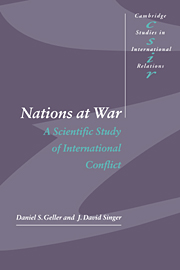Book contents
- Frontmatter
- Contents
- List of figures and tables
- Acknowledgements
- Introduction
- 1 Overview
- 2 Decision models
- 3 War-prone states
- 4 War-prone dyads
- 5 War-prone regions
- 6 War-prone systems
- 7 Case study: Iran/Iraq War (1980)
- 8 Case study: World War I (1914)
- 9 Conclusion
- Appendix 1 List of databases
- Appendix 2 Tables of references by category
- References
- Index
- Cambridge Studies in International Relations
9 - Conclusion
Published online by Cambridge University Press: 16 October 2009
- Frontmatter
- Contents
- List of figures and tables
- Acknowledgements
- Introduction
- 1 Overview
- 2 Decision models
- 3 War-prone states
- 4 War-prone dyads
- 5 War-prone regions
- 6 War-prone systems
- 7 Case study: Iran/Iraq War (1980)
- 8 Case study: World War I (1914)
- 9 Conclusion
- Appendix 1 List of databases
- Appendix 2 Tables of references by category
- References
- Index
- Cambridge Studies in International Relations
Summary
In 1970, Singer outlined his scientific approach toward uncovering the causes of international war and speculated as to the outcome. Specifically, he postulated that state attributes, relational characteristics within dyads, and system-level attributes might combine in creating a potent source of war:
It will almost certainly turn out that certain attributes do indeed make some nations more war-prone than others … I would, on the other hand, expect that these attributes – in order to exercise any consistent and powerful effect – have to interact with certain relational variables and with the attributes of the international system at the moment. A nation must, in a sense, be in the “right” setting if it is to get into war. Finally, there is little doubt that all of these ecological factors will have to be taken into account … if we are ever to understand the dynamic processes of behavior and interaction which are so large a part of conflict. (Singer 1970:537)
The analysis presented here has attempted to identify those factors and to demonstrate how they conjoin in influencing the onset of war among nations.
The preceding eight chapters of this book were designed to provide a scientific explanation of war in international politics grounded on data-based empirical research. The study began with an examination of two basic decisionmaking models – the rational and the nonrational – in relation to the explanatory framework of the volume.
Information
- Type
- Chapter
- Information
- Nations at WarA Scientific Study of International Conflict, pp. 191 - 195Publisher: Cambridge University PressPrint publication year: 1998
